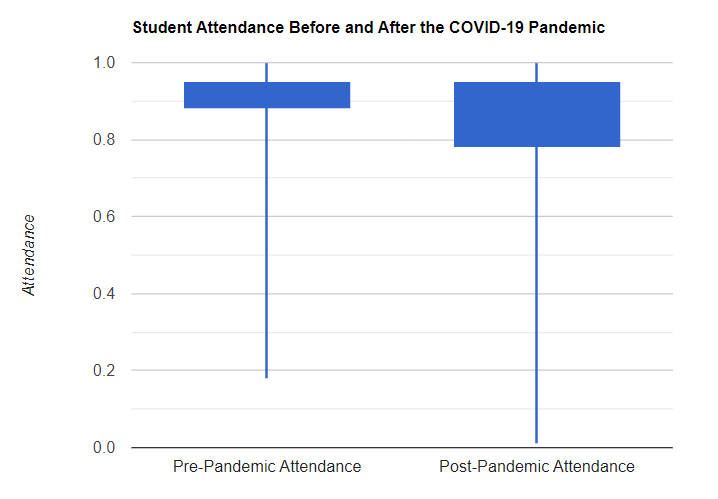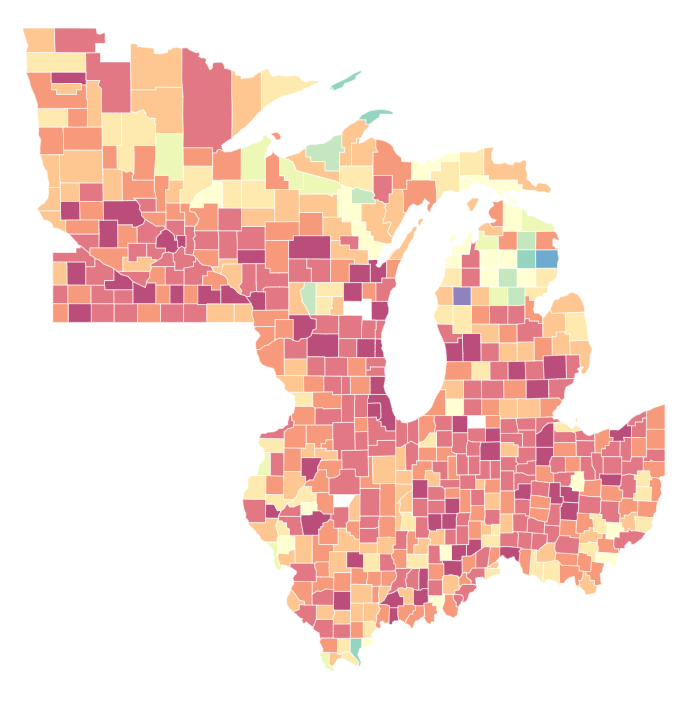Below, are some interactive plots for a project I worked on. They show the changes in HS GPA and Attendance after the COVID-19 pandemc for three high schools:
COVID-19 Vaccination Race
Just for fun this morning, I put together a horse race visualization for state-by-state COVID-19 Vaccinations rates. The viz uses NPR’s data, which updates daily, so it will update as often as NPR updates.
Right now, Maine is winning with just over 1/3 of its population vaccinated. Let’s keep racing to get to 70%!
Continue reading →Letter to the Editor: The Indiana GOP doesn’t care about you.
UPDATE 3/2: The local newspaper decided to publish my probably-a-little-too-long letter. You can check it out here (give them clicks!).
To the editor,
We’re all tired. It’s been a long year. We need our leaders to cut the crap and work on addressing the challenges Hoosiers face every day – a better economy, improved healthcare, education for our kids. The General Assembly should focus on these issues, but the GOP Supermajority has a different agenda – they would rather fight culture wars and help their wealthy friends. The republicans that we sent to represent us aren’t solving our problems; they’re creating new ones for us.
Continue reading →Remember Essential Workers?
Happy Labor Day, everyone! We shouldn’t forget about essential workers.
A few months ago, I wrote a post about how we don’t pay essential workers enough. At the time, it was a big topic. Essential workers were some of the only folks who had to actually show up to a physical location (ie: not their homes) for work still, and we were all concerned that they would get sick. Our leaders seemed poised to respond. And then they did nothing (mostly). Since then, we’ve heard nothing but crickets on the subject of essential workers. The drop in level of interest in essential workers is staggering. Check it out:
Continue reading →So…It’s been a while
Howdy! So…It’s been a while. This year really threw a wrench in everyone’s plans, including mine. Sadly, trying to balance the global pandemic, a new child, and work means that I’ve had little time to dig into or write about anything. I’ve only had time to shit-post on twitter for about 4 months now (which I’m getting really tired of). I hope to get back into a better routine soon.
In other, related news, just as the pandemic was really taking off, my spouse recieved an invite to apply for a new job in her hometown, Greencastle, IN. The new role was a big jump up for her professionally, and it also meant moving closer to family (her dad lives across town rather our closest family, my parents, living 50 miles away). We decided to explore it, and as she learned more, she concluded that it was the right career move. She got the job, and we started making plans to move.
After a little bit of stress about selling a house, working with movers, and findiing a new place, we’re finally (kind of) getting settled in here in Indiana.
Sadly, I’m not a Buckeye Anymore
So, yes, after focusing a lot of my energy on Ohio for the past few years, I’m no longer a resident of Ohio. And yes that makes me very very sad. I grew up in Ohio, and when I moved back home a few years ago, it felt really nice to come home. Just as I was settling back in, a great opportunity outside of Ohio came along. Ultimately, moving away is the right thing for our family.
So, I am now a hoosier (god, that feels wierd to write), but my heart will always be in Ohio. I still care (and will write) about Ohio, but now I will also focus on Indiana, the midwest, and well, whatever else I feel like writing about. I look forward to getting back into a routine that will allow some more depth than what’s possible in a tweet.
In the meantime, you can find me shit-posting on twitter. Feel free to say hello (especially if you have any tips about being a new hoosier). But more importantly, stay safe and healthy out there.
A Jobs-Housing Map for the Midwest Partnership
Howdy! It’s been a while, and I hope everyone is staying safe and healthy. As we’re starting to talk about reopening (probably too early) and recovery, I wanted to share another very brief post about housing
The housing crisis is everywhere, and part of our Coronavirus recovery should address it.
In light of regions of the country becoming mini-nation-states including a pact of Midwestern States and in an effort to get some more data, I put together this map, which shows the jobs-housing mismatch for the five states that are definitely part of the midwest, the former Northwest Territories:
Continue reading →Essential Workers Aren’t Paid Like They Are Essential
If they’re essential, shouldn’t they earn more?
I went to the grocery store the other day to stock up. Trying to avoid social contact as much as possible, I went very early on Saturday morning, when normally the store would be empty. I was surprised to find that the store was packed with shoppers, some wearing masks, many with carts that were bulging with supplies. Workers were busily stocking shelves to keep up with demand and every checkout had a line.
As I walked around, I tried to do some math in my head to see if I could determine the probability that someone in the store was carrying COVID-19 at that moment. The state of Ohio estimates that 100,000 people currently have the virus, so the math is pretty straightforward. If 100,000 people have the virus out 11.7 million Ohioans, then roughly 0.85% of folks are infected. That means that if you have 117 people in a space at a given time, it is likely that at least one of those 117 people are carrying coronavirus. Looking around the store, it seemed like there were more than 117 people there, and certainly, over the course of a single clerk’s shift, well over 117 people will come into the store. The likelihood that a typical Kroger employee is going to be exposed to COVID-19 is incredibly high.
Continue reading →We Should have More State Legislators
Well, at least I’m pretty sure we should.
2020 is another census year, which means there will be some electoral shakeups around the country as fast-growing states gain members of Congress and slower-growing/declining states lose representatives. For almost 100 years now, we’ve had this fixed-pie system at the national level, where states could lose seats in Congress if they aren’t keeping up. But that wasn’t always the case. When the US constitution was adopted, the House of Representatives was meant to have 1 member for every 30,000 people. For today’s population, that would come out to more than 11,000 members of Congress. Sure, it might mean that we have 25 AOCs, but it would also mean 25 Jim Jordans! No thanks.
Clearly, capping the number of Congressional Representatives at some number is necessary. 11,000 members of Congress is probably untenable, and fivethirtyeight.com’s name would seem so quaint. There have been some calls to increase the size of the house, and there is some good research out there about what the optimal size of the legislature should be. TLDR: the number of representatives in the lower house should be the cube root of the entire population, so in the US, the House should have around 688 members.
But what about state legislatures? So much policy happens at the state level: healthcare, transportation, zoning, criminal justice, minimum wage as well as culture war issues like abortion, gun control, and drug laws. It seems like we should also consider what the right levels of representation is for our state legislatures is too.
I played around with the data, and found that some states have really high levels of representations (North Dakota and Vermont, but whoa New Hampshire!), while others have a lot of people per representative (California in particular, but also Texas and Florida). Others are just weird (why only one house Nebraska, and do you really think the state legislator is a non-partisan position?). Here in Ohio, I think there’s a decent argument for a larger legislative body but before we get ahead of ourselves, let’s dig in!
Continue reading →Ohio’s Housing Crisis
Ratios of Housing to Jobs in parts of Ohio are as bad as the San Francisco Bay Area
Columbus homeowners have been celebrating news that their home values have skyrocketed in that last few years. The Columbus Dispatch in particular has been praising the local market, saying that homeowners are “sitting on a gold mine” as home values reach record highs. While praising current homeowners, the Dispatch had no problem blaming new home buyers for pushing up prices in affordable neighborhoods.
Honestly, I’m not interested in blaming anyone for the lack of affordability. It’s more important that we recognize that these soaring prices and lack of affordability are the first signs that we’re in a housing crisis. If we don’t address it, it will get worse. Lower-income folks are already feeling the impacts, and if we stay on our current trajectory, even more people are going to get left behind. The region will suffer for it. Before diving into the data, let’s take step back to examine why affordability is important and then take a look at just how bad it is here in parts of Ohio, particularly Central Ohio.
Continue reading →How much should we pay public servants?
I’m suspicious of anyone who’s willing to do public service for well under the market value of their work. You should be too.
I got into an argument last week on twitter (I know, I’m really doing this wrong) about how much we should pay public employees. I had read about Mount Vernon’s Assistant Law Director who was making about $68,000 and how the city council was considering giving her a raise. She had received some better-paying offers in the private sector. Apparently she’s doing good work, because her boss wanted to give her the raise to ensure she stays around. Some of the members of city council were hesitant to pay her more though.
Continue reading →






